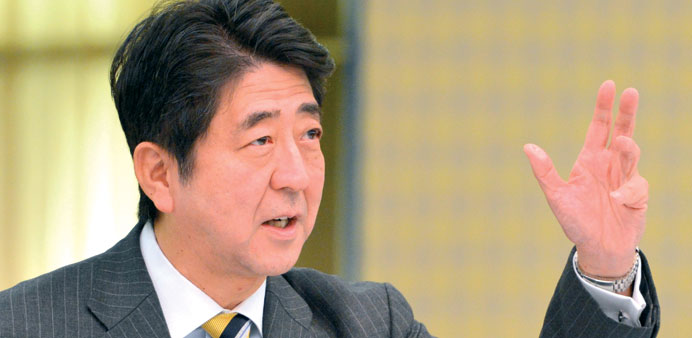Reuters, AFP/Tokyo
Japan won approval from participating countries to join talks on a US-led Asia Pacific free trade agreement, central to Prime Minister Shinzo Abe’s plans to open the economy to more competition and revive growth.
The formal invitation for Tokyo to join the negotiations was extended at a meeting of members of the Trans-Pacific Partnership (TPP) yesterday on the sidelines of the Asia-Pacific Economic Co-operation gathering in Surabaya, Indonesia, according to a joint statement.
The decision became unanimous when Canada “successfully concluded” consultations with Japan after being the sole nation of 11 in the US-driven Trans-Pacific Partnership (TPP) that still opposed Tokyo’s participation.
“These consultations have been informed by a robust and ongoing engagement with Canadian stakeholders, and it’s that engagement that helped inform this process,” Canadian Trade Minister Ed Fast said in a statement sent to AFP.
“We look forward to continuing to work together (with Japan) to deepen our trade and investment relationship in a manner that will generate significant benefits for hard-working people in both our countries.”
Fast said the TPP offered “tremendous opportunity to expand Canada’s partnerships in Asia” while strengthening relationships in the Americas.
“Concluding an agreement with our TPP partners that advances Canadian interests is a key part of our government’s ambitious pro-trade plan,” Fast said.
With the entry of Japan, the third-largest economy, into the free-trade talks the pact would cover nearly 40% of the global economy, making it the biggest free-trade agreement in the world.
The bloc is aimed creating a tariff-free zone with a market of around $25tn covering some 800mn people.
Although member countries had expressed interest in Japan joining the talks, many wanted to see Tokyo make firm commitments in reducing tariffs on imports.
Japan will join 11 nations already in talks on the TPP: the US, Canada, Mexico, Peru, Chile, Vietnam, Malaysia, Singapore, Brunei, Australia and New Zealand. Members hope to reach a deal by the end of this year.
With the world’s third-largest economy on board, the final TPP pact would cover nearly 40% of global economic output and one-third of all world trade.
Abe has prescribed a three-part economic plan of hyper-easy monetary policy, big fiscal spending and steps to spur longer-term growth, including de-regulation and government backing to beat deflation and engineer lasting recovery. Joining the TPP talks is seen as the first, key element of that growth strategy.
“Japan’s participation in the negotiation will underscore the economic significance of TPP and its promise as a pathway toward a Free Trade Area of the Asia Pacific,” said the joint statement by trade ministers of the TPP member nations.
Japan hopes to participate in the July round of negotiations, which would require the White House to quickly give Congress 90-day notice of its intention to begin trade talks with Tokyo.
A 17th round of talks is currently scheduled for May in Peru. The dates and location of the 18th round in July have not yet been announced.
Last week, Japan struck a deal with the US to get Washington’s support to join the TPP talks.
The TPP talks are officially slated to conclude this year, although many trade experts expect them to stretch into 2014.
Japan is hoping to protect key agriculture goods such as rice, wheat and dairy products to appease its politically powerful farm lobby.
“Japan will aim to secure tariffs on agricultural products after entering the TPP talks. The situation is quite tough but we have not given up,” a senior government official said.
Kazuhito Yamashita, research director at the Canon Institute for Global Studies, said Japan should be looking beyond the TPP to boost broader trade ties.
“Japan can have bargaining power as the nation is the only one involved in trade talks such as the TPP, Japan-EU, Japan-China-Korea, and the RCEP,” he said.
Talks on a Regional Comprehensive Economic Partnership trade block include the 10-nation Association of South East Asian Nations (Asean) along with Japan, China, South Korea, Australia, New Zealand and India, but not the US.
“Japan is in a very interesting strategic position. Japan could become a hub in South East Asia and a bridge between the region and the West if the authorities clearly understand this.”
Fast said the TPP offered “tremendous opportunity to expand Canada’s partnerships in Asia” while strengthening relationships in the Americas.
“Concluding an agreement with our TPP partners that advances Canadian interests is a key part of our government’s ambitious pro-trade plan,” Fast said.
With the entry of Japan, the third-largest economy, into the free-trade talks the pact would cover nearly 40% of the global economy, making it the biggest free-trade agreement in the world.
The bloc is aimed creating a tariff-free zone with a market of around $25tn covering some 800mn people.
Although member countries had expressed interest in Japan joining the talks, many wanted to see Tokyo make firm commitments in reducing tariffs on imports.
Washington earlier this month gave Japan the thumbs-up for talks on the free-trade agreement despite opposition from Japanese farmers and some US labour groups and manufacturers.
To allay concerns of higher competition in the US automotive industry, Japan agreed that US tariffs on its cars would be phased out at the latest possible time allowed by a future accord.
President Barack Obama has championed the TPP as a way to boost the US economy through trade and to build a US-driven order in a fast-growing region where China — which is not part of the talks — is gaining clout.

